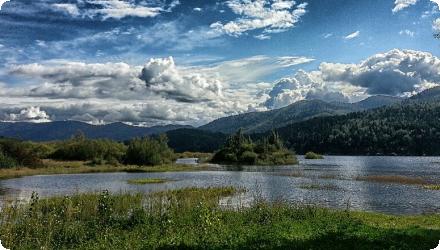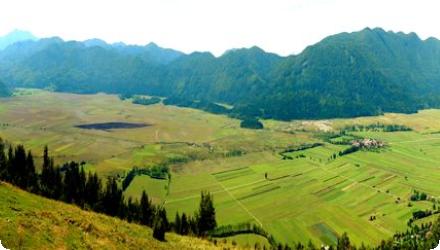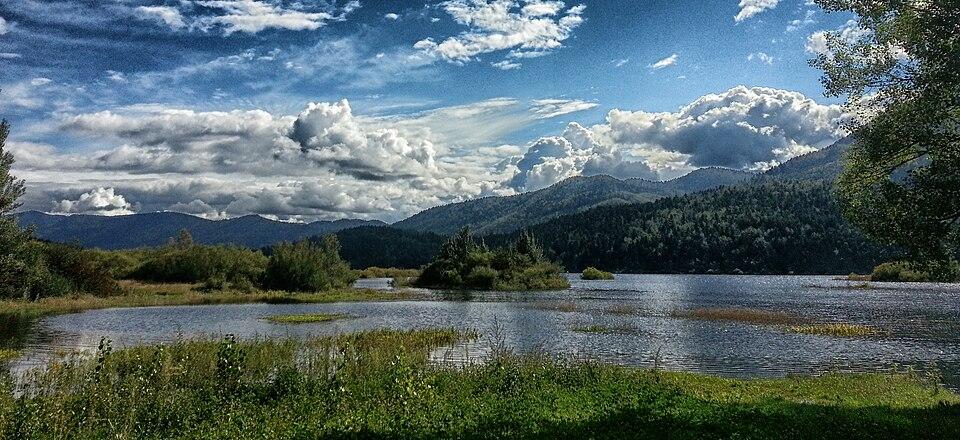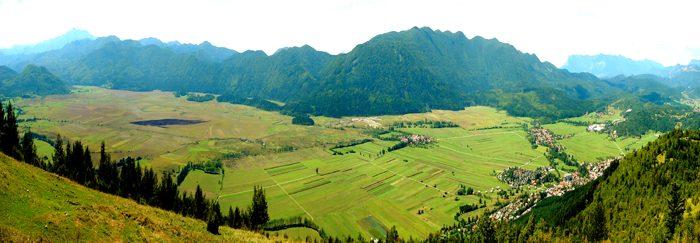Last update
2025
Summary
The project aimed to create suitable conditions for protecting and conserving species and habitats at Lake Cerknica, Slovenia’s largest intermittent lake, while promoting sustainable agriculture, forestry, fishing, tourism, recreation, and education in harmony with natural values. Coordinated by Notranjska Regional Park with the Biotechnical Faculty, the Municipality, and Inženiring za vode d.o.o., it was funded by the LIFE programme.
Following the initial actions (2007–2009) – including land purchase, riverbed restoration, and wet grassland management – successive LIFE projects have continued and expanded this work. LIFE STRŽEN (2017–2023) restored over 2 km of the Stržen riverbed, improved hydrological conditions over 60 ha, enhanced habitats for priority bird species such as the bittern, and reduced tourism pressures. The ongoing LIFE TRŠCA (2023–2029) focuses on managing marsh habitats for waterfowl, adapting mowing regimes, removing excess biomass, reducing disturbance, and introducing innovative biomass use. Recent monitoring combines field surveys and satellite imagery to track water levels and reedbed dynamics, ensuring long-term ecological resilience and adaptive management of this Natura 2000 site.
Following the initial actions (2007–2009) – including land purchase, riverbed restoration, and wet grassland management – successive LIFE projects have continued and expanded this work. LIFE STRŽEN (2017–2023) restored over 2 km of the Stržen riverbed, improved hydrological conditions over 60 ha, enhanced habitats for priority bird species such as the bittern, and reduced tourism pressures. The ongoing LIFE TRŠCA (2023–2029) focuses on managing marsh habitats for waterfowl, adapting mowing regimes, removing excess biomass, reducing disturbance, and introducing innovative biomass use. Recent monitoring combines field surveys and satellite imagery to track water levels and reedbed dynamics, ensuring long-term ecological resilience and adaptive management of this Natura 2000 site.
Position
Latitude
45.7425
Longitude
14.363
Project
NWRM
National Id
Slovenia_03
Installation date
2009-12
Implementation Status
Contact
Jovanka Ignjatovic, REC
RBD code
SI_RBD_1
Transboundary
0
Photo gallery
Location of the project
Lake Cerknica (Cerkniško jezero), within Notranjski Regional Park, Municipality of Cerknica, Inner Carniola, Slovenia.
NUTS Code
SI02 - Zahodna Slovenija
Project's objectives
The project aims to ensure long-term favorably conditions for the conservation of turloughs and other endangered habitat types and associated plant and animal species at Lake Cerknica. It simultaneously promotes sustainable development of local agriculture, forestry, fishing, tourism, recreation and education in accordance with natural values.
Involved Partners
| Authority type | Authority name | Role | Comments |
|---|---|---|---|
Climate zone
cool temperate moist
Temperature
8
Precipitation
1700
Runoff
6
Runoff range
600 - 750 mm
Evapotranspiration
708
Elevation range
553
Vegetation class
Cerknica Lake is one of the most important Slovenian Karst sights. When the water level is highest it covers over 29 km2. Lakes most significant characteristic is its intermittent nature. Due to this variability, special ecological conditions were created on the lake that enables rich diversity of animal and plant species and their habitats. The area is mostly covered with permanent pasture areas and marshy areas. Due to frequent flooding the extensive agricultural land use is dominated (wet meadows, pastures, fields).
Water bodies: Ecological Status
Good
Water bodies: Chemical Status
Failing to achieve good
Water quality status
Historic channelization and sinkhole works altering the regime
Project scale
Meso
Project scale specification
It covers the Lake Cerknica and Cerkniško polje area within Notranjski Regional Park, a Natura 2000 site of regional importance. The interventions (river re-meandering, wetland and marsh management, habitat restoration) target a sub-basin and its floodplain rather than a single point site, but are not at the scale of an entire national catchment.
Performance timescale
1 - 4 years
Project area
2900
Area subject to Land use change or Management/Practice change (ha)
3
Size
1400
Size unit
m
Lifespan
50
Design capacity description
A land survey of current and former watercourses on an area larger than 100 ha was carried out as the bases for re-naturalization of former meanders. More than 12 km of watercourses in the Cerknica were included in this study. By restoring former meanders of two streams it was intended to raise the groundwater level in the area. Restoration works were done on few sections, approximately 1400 m long.
Total cost
€6,803,449
Costs other information
Initial LIFE project – LIFE06 NAT/SLO/000069 (2007–2009) : €1,813,010
Follow-up LIFE project – LIFE16 NAT/SI/000708 (LIFE STRŽEN, 2017–2023) : €1,776,122
Current LIFE project – LIFE22 NAT/SI/LIFE TRŠCA (2023–2029) : €3,214,317
Follow-up LIFE project – LIFE16 NAT/SI/000708 (LIFE STRŽEN, 2017–2023) : €1,776,122
Current LIFE project – LIFE22 NAT/SI/LIFE TRŠCA (2023–2029) : €3,214,317
Financing authorities
Type of funding
EU-funds: LIFE+
Comments
Initial LIFE project – LIFE06 NAT/SLO/000069 (2007–2009) : €1,324,492 (73 %)
Follow-up LIFE project – LIFE16 NAT/SI/000708 (LIFE STRŽEN, 2017–2023) : €1,333,708
Current LIFE project – LIFE22 NAT/SI/LIFE TRŠCA (2023–2029) : €2,410,737
Follow-up LIFE project – LIFE16 NAT/SI/000708 (LIFE STRŽEN, 2017–2023) : €1,333,708
Current LIFE project – LIFE22 NAT/SI/LIFE TRŠCA (2023–2029) : €2,410,737
Type of funding
National funds
Comments
Initial LIFE project – LIFE06 NAT/SLO/000069 (2007–2009) : €488,518
Follow-up LIFE project – LIFE16 NAT/SI/000708 (LIFE STRŽEN, 2017–2023) : €442,414
Current LIFE project – LIFE22 NAT/SI/LIFE TRŠCA (2023–2029) : €803,580
Follow-up LIFE project – LIFE16 NAT/SI/000708 (LIFE STRŽEN, 2017–2023) : €442,414
Current LIFE project – LIFE22 NAT/SI/LIFE TRŠCA (2023–2029) : €803,580
Policy context
The Cerknisko Jezero project substantially improved the quality of the Cerknica Lake Natura 2000 site and raised awareness of the sites importance locally and beyond. It demonstrated new approaches to nature conservation in Slovenia, particularly the purchase of farmland for permanent protection and advanced mowing and mulching techniques on wetlands.
Land ownership
A mix of ownerships: part of the land was purchased for conservation by Notranjski Regional Park. The rest includes private parcels (farmers, local residents) and other public land within the Natura 2000 site.
Community involvment
No
Design consultation activity
| Activity stage | Name | Key issues | Comments |
|---|---|---|---|
|
Implementation phase
|
Popularization of the project
|
The project was highly active in engaging the public, including through information notices in a shopping centre, published materials and lakeside boards.
|
Public was informed about the course of the project on more different levels:
Lectures and other activities for local and general public (31 lectures for professional, local and general public were performed that had very good media support both on local and national level), Articles in local and national newspapers (102 articles in printed media, mostly in local newspapers were published. 22 articles were also published in the monthly bulletin eNatura under the Ministry of Environment and Spatial Planning), Announcements on radio and TV stations (There were 117 publications on local and national TV and radio stations, concerning the LIFE project. The project group regularly cooperated with local radio stations, the public was informed about the importance of nature protection and conservation. The project group also cooperated in radio show named Rompompom for young people, for which 5 broadcasts were prepared), Contributions concerning the nature protection and conservation were published monthly on the local TV station (the project and work within was presented in several talk shows on the local TV station. The advertisement for buying agricultural land in the area of Lake Cerknica was also regularly transmitted). |
|
Implementation phase
|
Work with youth
|
Project conducted nature protection actions with a network of schools.
|
As a future investment, one of the project team's goals was to meet all schoolchildren that live in Notranjska Regional Park and present them the project and actions within it.
The following activities within this action were carried out: Establishment of Nature protection network of schools and kindergartens of Notranjska Regional Park, Educational activities, Preparation of educational materials, Summer research camps). |
Policy target
| Target purpose |
|---|
|
Improved Biodiversity
|
|
Groundwater Recharge
|
|
Increase Water Storage
|
|
Runoff control
|
|
Oher Societal Benefits
|
Policy pressure
| Pressure directive | Relevant pressure |
|---|
Policy impact
| Impact directive | Relevant impact |
|---|
Requirement directive
| Requirement directive | Specification |
|---|
Contractual arrangements
0
| Arrangement type | Responsibility | Role | Name | Comments |
|---|
Part of wider plan
1
Wider plan type
| Wider plan type | Wider plan focus | Name | Comments |
|---|---|---|---|
|
National
|
Spatial Development Strategy of Slovenia
|
||
|
Regional
|
Decree on the spatial and social components of a long-term plan of the municipality Cerknica
|
||
|
Local
|
Amendments to the general planning conditions Municipality of Cerknica
|
Monitoring is carried out by Notranjski Regional Park with support from project partners and experts. It is required under LIFE projects to assess habitat conditions, species populations, and hydrological dynamics.
Parameters include hydrological conditions (lake water level, duration of inundation, reedbed flooding) monitored both in the field and via satellite imagery; vegetation dynamics in wet meadows and reedbeds, assessed through biomass surveys, mapping, and phenological observations; and target species populations, notably waterfowl such as the bittern (Botaurus stellaris), ferruginous duck, and red-necked grebe, monitored during breeding seasons. Socio-environmental factors such as visitor numbers and disturbance levels are also recorded to evaluate the effectiveness of access management measures.
Maintenance
The ongoing maintenance consists mainly of seasonal mowing of wet meadows and marshes to prevent overgrowth, and periodic removal of excess biomass in targeted reedbeds and marsh habitats.
Unknown
Tourism management: LIFE STRŽEN reduced visitor disturbance to sensitive habitats by an estimated 80 %, thanks to rerouted trails, regulated access, and parking reorganisation.
Recreation and eco-tourism: improved visitor infrastructure (viewing points, information panels) supports nature-based tourism in a controlled way.
Agriculture: maintained traditional mowing and hay production (≈ 500 t/year from 26 ha), providing fodder for local farmers and preserving agri-environmental payments.
Employment: LIFE projects created jobs for restoration works, biomass harvesting, monitoring, and guiding (no exact number reported).
Recreation and eco-tourism: improved visitor infrastructure (viewing points, information panels) supports nature-based tourism in a controlled way.
Agriculture: maintained traditional mowing and hay production (≈ 500 t/year from 26 ha), providing fodder for local farmers and preserving agri-environmental payments.
Employment: LIFE projects created jobs for restoration works, biomass harvesting, monitoring, and guiding (no exact number reported).
Information on retained water
Raised groundwater level at Dujce fen through re-meandering of ~1.4 km of the Stržen riverbed (LIFE06). Improved hydrological conditions over 60 ha of turlough habitat after LIFE STRŽEN (2017–2023) restoration of 2.1 km of river meanders. Increased retention capacity in the restored area, extending flooding duration in certain zones and enhancing soil moisture.
Water quality overall improvements
Not relevant for this application
Soil quality overall soil improvements
Not relevant for this application
1
Improved water regime has a positive impact on the prevalence and size of certain Natura 2000 habitat types (depressions on peat substrates, transitional bogs, meadows). Modified water regime has a direct impact on macrophyte, amphibious and wading species.
Slower flow of water and lower water level fluctuations affect a positive impact on the breeding of witnesses and reproduction and spawning green frogs, as well as spawning fish.
Modified water regime allows for long-term species diversity of dragonflies, water beetles and caddisflies.
Slower flow of water and lower water level fluctuations affect a positive impact on the breeding of witnesses and reproduction and spawning green frogs, as well as spawning fish.
Modified water regime allows for long-term species diversity of dragonflies, water beetles and caddisflies.
Ecosystem impact climate regulation
No specific impact
Information on Ecosystem impact climate regulation
Not relevant for this application
Ecosystem provisioning services
0
Information on Ecosystem provisioning services
Not relevant for this application
Key lessons
The project was aimed at ensuring long-term favorable conditions for the conservation of endangered habitat types and associated plant and animal species at Lake Cerknica. The main focus was given to the restoration of the natural watercourses with the aim of prolonging the drainage time and holding back the water in the driest summer months. This contributed to raising the level of groundwater, particularly close to riverbeds or watercourses, crucial for conserving endangered habitat types and species.
The project substantially improved the quality of the Cerknica Lake Natura 2000 site and raised awareness of the site’s importance locally and beyond. It demonstrated new approaches to nature conservation in Slovenia, particularly the purchase of farmland for permanent protection and advanced mowing and mulching techniques on wetlands.
A key lesson has been the importance of ensuring continuity through successive projects. The gains from the initial restoration were strengthened and expanded in later phases, showing that long-term planning is essential for complex wetland systems. Another is that integrating conservation measures with traditional land uses, such as seasonal mowing and haymaking, can align biodiversity goals with local livelihoods, improving acceptance and participation.
Visitor access management proved effective in reducing disturbance to sensitive bird species while still supporting nature-based tourism. Finally, combining traditional field surveys with modern tools like satellite imagery provided an efficient and scalable way to monitor hydrology and vegetation, enabling truly adaptive management.
The project substantially improved the quality of the Cerknica Lake Natura 2000 site and raised awareness of the site’s importance locally and beyond. It demonstrated new approaches to nature conservation in Slovenia, particularly the purchase of farmland for permanent protection and advanced mowing and mulching techniques on wetlands.
A key lesson has been the importance of ensuring continuity through successive projects. The gains from the initial restoration were strengthened and expanded in later phases, showing that long-term planning is essential for complex wetland systems. Another is that integrating conservation measures with traditional land uses, such as seasonal mowing and haymaking, can align biodiversity goals with local livelihoods, improving acceptance and participation.
Visitor access management proved effective in reducing disturbance to sensitive bird species while still supporting nature-based tourism. Finally, combining traditional field surveys with modern tools like satellite imagery provided an efficient and scalable way to monitor hydrology and vegetation, enabling truly adaptive management.
Success factor(s)
| Success factor type | Success factor role | Comments | Order |
|---|---|---|---|
|
Attitude of relevant stakeholders
|
main factor
|
1
|
|
|
Financing possibilities
|
main factor
|
2
|
|
|
Communication activities
|
secondary factor
|
3
|
Driver
| Driver type | Driver role | Comments | Order |
|---|---|---|---|
|
Organisation committed to it
|
main driver
|
Cerknica lake is one of the most important Slovenian Karst sights known worldwide. In the past people wanted either to drain or to flood the lake for their benefit. Many interventions were carried out on lakes watercourses and sinkholes that changed the water regime on the lake. The result of the changed water regime is a lower ground water level and faster drying of the lake that has a negative influence on water organisms and habitats.
With the act and establishment of a public institution Notranjska Regional Park in 2002 the lake has gained the legal protection. |
1
|
Source(s)
English



